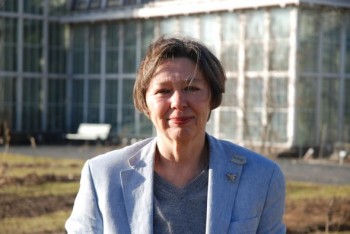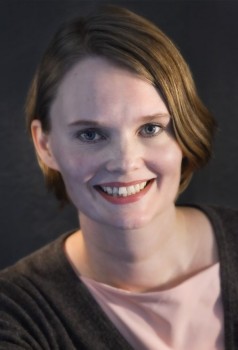Reviews
Vilja-Tuulia Huotarinen: Kimmel
5 February 2015 | Mini reviews, Reviews
 Kimmel
Kimmel
Hämeenlinna: Karisto, 2014. 120 pp.
978-951-23-5840-3
€22.90, hardback
In Kimmel, Vilja-Tuulia Huotarinen, known also for her poetry, presents no fewer than 12 teenage girls whose fates are left to be pondered long after the story is completed. Kimmel is a girl hero whose parents place the rescue of the entire planet on her shoulders. She has no doubt she will succeed in her task. She acquires a small pink airplane decorated with glitter – even though ‘there’s really nothing soft and pretty and hello-kitty about sixteen year olds’. For her companion on this epic trip Kimmel gets an interactive night book that empathises with her feelings and sometimes gives her concrete advice. Kimmel can be seen as a modern version of classic girl’s books – the author plays with girl’s book clichés but challenges the reader to think about myths of womanhood and the limits set by society. Huotarinen writes about the explosions of joy and the depths of sadness in girlhood with magical poignance and poetry.
Translated by Lola Rogers
Saku Heinänen: Zaida ja lumienkeli [Zaida and the snow angel]
29 January 2015 | Mini reviews, Reviews
 Zaida ja lumienkeli
Zaida ja lumienkeli
[Zaida and the snow angel]
Kuvitus [Ill. by]: Saku Heinänen
Helsinki: Tammi, 2014. 207 pp., ill.
ISBN 978-951-31-7631-0
€25.90, hardback
The adopted child’s story is already a familiar one from old classics of girl’s literature. This debut novel by Saku Heinänen, the story of Zaida, a girl adopted from India, draws on this tradition, yet Heinänen (born 1968), a professor in graphic design at Aalto University, succeeds in creating a fresh and original setting and sympathetic central characters. Zaida is used to talking openly with her parents, but bullying at school makes her withdraw into her shell. She gets her strength from a soul sister who understands her bad moods. This tension is what gives this novel its extraordinary suspense. Heinänen’s book doesn’t paint a child’s everyday life as idyllic – there are many kinds of secrets in one little family. Zaida’s uncle is prone to drink and melancholy, but the two are still close. Heinänen also illustrated the book and designed his own font – Freya – just for the book. His wife is children’s book author and illustrator Christel Rönns.
Translated by Lola Rogers
Jenni Erkintalo: Värejä meressä [Colours in the sea]
29 January 2015 | Mini reviews, Reviews
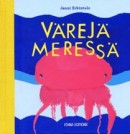 Värejä meressä
Värejä meressä
[Colours in the sea]
Kuvitus [Ill. by]: Jenni Erkintalo
Helsinki: Etana Editions, 2014. 32 pp., ill.
ISBN 978-952-7105-00-9
€17.90, hardback
In recent years a large number of board books have appeared in Finland: many of the graphic artists and designers of the younger generation have taken an interest in them. The style is generally modern, but unfussy and easy for a child to make sense of. Graphic artist Jenni Erkintalo’s (born 1978) picture book debut is ebullient, in all its simplicity. With supple rhyming text and minimal drawings, little readers are guided through the beginnings of learning colours. The three primary colours give birth to new colours and the illustrations demonstrate the mixture of colours in a fun way. The book has thick cardboard pages that can stand up to even a two-year-old’s rough handling.
Translated by Lola Rogers
Marjo Vilkko: Suomi on ruotsalainen [Finland is Swedish]
16 January 2015 | Mini reviews, Reviews
 Suomi on ruotsalainen
Suomi on ruotsalainen
[Finland is Swedish]
Helsinki: Schildts & Söderströms, 2014. 321 pp.
ISBN 978-951-52-3419-3
€36, hardback
Finland was a part of the Swedish kingdom from the deep Middle Ages until 1809, when for a hundred years it was incorporated into Russia. The Swedish period left profound traces in Finnish society, and these were examined – with lively discussion – in the television series Finland is Swedish. Now the series scriptwriter and editor Marjo Vilkko has provided a more thoroughgoing treatment of the topic in her book. Although Finland is a country that shares Western and Nordic values, it differs from Sweden in several respects. For historical reasons and due to the presence of a significant Swedish-speaking minority, Swedish is still an official language; many things have moved from Europe to Finland via Sweden. However, at times the differences in Finland’s development have been emphasised by those wishing to propagate ‘original Finnish’ characteristics. With the use of fascinating examples and reflections drawn from history, Vilkko shows, for example, how Finland’s local government, legal system and Lutheran religion are to a large extent an inheritance from the Swedish period, with a continuous mutual interaction. The book moderately propagates the recognition of a common heritage and support for mutual understanding.
Translated by David McDuff
Aho & Soldan: Helsinki 1950-luvun väreissä / Helsingfors in 1950-talets färger / Helsinki in 1950’s colours
11 January 2015 | Mini reviews, Reviews
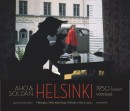 Aho & Soldan: Helsinki 1950-luvun väreissä / Helsingfors in 1950-talets färger / Helsinki in 1950’s colours
Aho & Soldan: Helsinki 1950-luvun väreissä / Helsingfors in 1950-talets färger / Helsinki in 1950’s colours
Teksti / text: Eino Leino
Translation into Swedish by Marjut Hökfelt, into English by Elina Adams
Helsinki: Gummerus, 2014. 168 pp., ill.
ISBN 978-951-20-9527-8
€36.90, hardback
The photographer Claire Aho (born 1925) is the granddaughter of the author and journalist Juhani Aho (1861–1921) and his artist wife Venny Soldan-Brofeldt. Two of Aho’s sons, Heikki and Björn, became photographers and documentary film producers, founding the company Aho & Soldan. In the 1940s Heikki’s daughter Claire began to work for Aho & Soldan and becme a well-known fashion photographer. She also began photographing her native Helsinki; in 1952 she was assigned to film the Helsinki Summer Olympics. She continued her collaboration with Pathé News until the early 1960s. Colour came, literally, into the picture after the war; the photographs in this book feature life in the 1950s Helsinki. The photographs in their gently faded colours of the still small city, its inhabitants, parks, buildings and monuments are taken by either the two brothers or Claire Aho – in their time they were all signed just by Aho & Soldan. In his essay journalist Eino Leino portrays life in the city that he remembers from his own childhood in the post-war era, which to today’s reader appears sweetly idyllic, somehow optimistic and peaceful; the city has changed greatly – and yet stayed the same.
Herman Lindqvist: Kun Suomi oli Ruotsi [When Finland was Sweden]
18 December 2014 | Mini reviews, Reviews
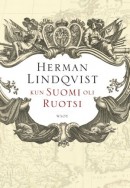 Kun Suomi oli Ruotsi
Kun Suomi oli Ruotsi
[When Finland was Sweden]
(original Swedish title: När Finland var Sverige, 2013)
Suom. [Translated from Swedish by] Heikki Eskelinen
Helsinki: WSOY, 2014. 497 pp., ill.
ISBN 978-951-0-40491-1
€44, hardback
The Swedish historian and journalist Herman Lindqvist is the author of dozens of popular non-fiction books. When Finland was Sweden is primarily intended for Swedish readers – an overview of the period when Finland was part of the Swedish kingdom – and it is partly based on new research. Finland became an integral part of the western neighbouring country in stages – including armed force – a process that was complete by the beginning of the fourteenth century. It remained an eastern borderland of the Kingdom of Sweden until the year 1809. The period was marked both by the rise of Sweden in the 16th century to become a great Baltic power and its decline in that role a hundred years later. Lindqvist connects up the different stages of Finland’s absorption into Sweden in a colourful and lively way. He shows how the influences went in both directions between the western and eastern part of the kingdom; the influence of the Finns could be seen both on the battlefields and in politics. The traces of the long time the two countries spent together are still visible today in both, thought in Finland they are stronger than in Sweden.
Translated by David McDuff
Esko-Juhani Tennilä: Jäämeri kutsuu. Koillisväylä, Murmansk ja Suomen mahdollisuudet [The call of the Arctic Sea. The Northeast Passage, Murmansk and Finland’s opportunities]
11 December 2014 | Mini reviews, Reviews
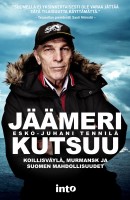 Jäämeri kutsuu. Koillisväylä, Murmansk ja Suomen mahdollisuudet
Jäämeri kutsuu. Koillisväylä, Murmansk ja Suomen mahdollisuudet
[The call of the Arctic Sea. The Northeast Passage, Murmansk and Finland’s opportunities]
Helsinki: Into Publishing, 2014. 332 pp., ill.
ISBN 978-952-264-197-7
€26, paperback
Esko-Juhani Tennilä is a Lapland-born editor, left-wing politician, former MP and author. The call of the Arctic Sea is a travel book and reportage book about Russia’s Murmansk and the neighbouring areas. Murmansk is a major port city whose harbour is ice-free in winter, and it is the largest city in the Arctic Circle. Nearby there are large ore, gas and oil resources. Global warming is beneficial to the region’s operating environment. Tennilä provides a fluent and well-backgrounded account of the experiences of entrepreneurs, politicians, decision-makers and ordinary people; he also meets Finns and Skolts, the Russian Sámi. Many foreign (e.g. Norwegian) companies are interested in the area. There is also activity by Finnish firms, but according to Tennilä not enough, and the Finnish State has not been able to actively take advantage of the economically important and interesting opportunities within the region along its northern border.
Translated by David McDuff
Mirkka Lappalainen: Pohjolan Leijona. Kustaa II Aadolf ja Suomi 1611–1632 [Lion of the North. Gustavus Adolphus and Finland, 1611–1632]
3 December 2014 | Mini reviews, Reviews
 Pohjolan Leijona. Kustaa II Aadolf ja Suomi 1611–1632
Pohjolan Leijona. Kustaa II Aadolf ja Suomi 1611–1632
[Lion of the North. Gustavus Adolphus and Finland, 1611–1632]
Helsinki: Siltala, 2014. 321 pp., ill.
ISBN 978-952-234-242-3
€31.50, hardback
The book presents a diverse and vivid history of the reign of Gustavus Adolphus – possibly the most important ruler in Swedish history – his era and his impact on Finland. When he rose to the throne at the age of just 17 in 1611, Finland was a strategically important region because of the threat posed by Russia and Poland. Among other things the king organised a meeting of representatives of the estates in Finland, the Regional Parliament of 1616 – even though he felt distrust of the Finnish people, who had supported the Polish King Sigismund, who had sought the Swedish crown. When the threat from the East had been repelled, Finland remained as a marginal corner of the world, which mainly provided taxes and soldiers. In 1630 the King, as a Lutheran soldier of faith, took his troops to Germany to fight in the Thirty Years War, and fell in 1632. However, in the period described the Swedish state, with Finland as a part of it, became a centralised state led by the King and his Chancellor Axel Oxenstierna, a system of government that was one of the most efficient in Europe. Lappalainen received the Finlandia Prize for Non-Fiction 2014 for her book.
Translated by David McDuff
Erkki Tuomioja: Siinä syntyy vielä rumihia. Poliittiset päiväkirjat 1991–1994 [Heads will roll. Political diaries 1991–1994]
20 November 2014 | Mini reviews, Reviews
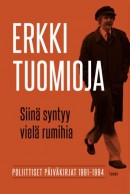 Siinä syntyy vielä rumihia. Poliittiset päiväkirjat 1991–1994
Siinä syntyy vielä rumihia. Poliittiset päiväkirjat 1991–1994
[Heads will roll. Political diaries 1991–1994]
Editor: Veli-Pekka Leppänen
Helsinki: Tammi, 2014. 680 pp., ill.
ISBN 978-951-31-7555-9
€39, hardback
Erkki Tuomioja (born 1945) has for a long time served as a member of parliament and as Finland’s foreign minister. A left-wing Social Democrat, Tuomioja has since his youth been known as a sharp-minded social debater as well as a writer and researcher. His publications include a biography of his grandmother, the Estonian-born eminent writer and dramatist Hella Wuolijoki. These fascinating political diaries from the early 1990s cover such topics as the break-up of the Soviet Union, Finland’s increasingly close integration with western Europe, and with the disputes about the Social Democrat leadership and the remarkable rise of Martti Ahtisaari, who came in from outside to become the party’s presidential candidate, and ultimately the country’s president. Tuomioja’s characterisations of Finnish politicians and political life are apt and plain-spoken, with particular criticism reserved, for example, for President Ahtisaari. Tuomioja does not conceal his own doubts and disappointments, and accepts that some of his views of the time do not correspond to those that he holds today. The editor provides the reader with a summary of the important events at the beginning of each month.
Translated by David McDuff
Panu Rajala: Tulisoihtu pimeään. Olavi Paavolaisen elämä [A torch into the darkness. The life of Olavi Paavolainen]
13 November 2014 | Mini reviews, Reviews
 Tulisoihtu pimeään. Olavi Paavolaisen elämä
Tulisoihtu pimeään. Olavi Paavolaisen elämä
[A torch into the darkness. The life of Olavi Paavolainen]
Helsinki: WSOY, 2014. 624 pp., ill.
ISBN 978-951-040254-2
€32.90, hardback
In the 1920s Olavi Paavolainen (1903–1964) became the charismatic figurehead of the influential Tulenkantajat (‘Firebearers’) movement, which placed emphasis on internationalism and modernism. After the movement broke up Paavolainen worked as a prominent cultural leader and critic who knew how to provoke and to arouse admiration. The original travel book he wrote about Nazi Germany in peacetime is still read, as is his book Synkkä yksinpuhelu (‘A sombre monologue’, 1946), based on the diaries he kept during the Second World War. The criticism the book received (and doubts about its author’s ‘wisdom of hindsight’) contributed to Paavolainen’s silence as a writer. Although in the 1950s and 1960s as a director he brought about a flourishing of radio drama at the Finnish Broadcasting Company, he became an alcoholic. Much has been written about Paavolainen, but author and researcher Panu Rajala’s popular biography has managed to find new perspectives and gives a vivid portrayal of Paavolainen’s personality, the writers he knew, the colourful story of his complex relationships with women, and his travels. There is less analysis of his literary production, though the content and reception of his books are discussed.
Translated by David McDuff
Finlands svenska litteratur 1900–2012 [Finland’s Swedish literature 1900–2012]
6 November 2014 | Mini reviews, Reviews
 Finlands svenska litteratur 1900–2012
Finlands svenska litteratur 1900–2012
[Finland’s Swedish literature 1900–2012]
Red. [Edited by] Michel Ekman
Helsingfors: Svenska litteratursällskapet i Finland / Stockholm: Atlantis, 2014. 376 pp., ill.
ISBN 978-951-583-272-6
€35.90, paperback
This history of Finland-Swedish literature is an updated version of the second volume of Finlands svenska litteraturhistoria (eds. Johan Wrede and Clas Zilliacus, 1999–2000), and it concentrates on the period from 1900 to 2012, with much new critical material relating to the years after 1975. Some 20 contributors under the editorship of Michel Ekman provide a diverse and inclusive overview of a literature that embraces poetry, prose fiction, children’s writing, essays and drama. The book traces the story of Finland-Swedish literature from the ‘fresh start’ of the turn of the 19th century, through the experiments of modernists like the poets Edith Södergran and Elmer Diktonius, to the work of present-day novelists like Monika Fagerholm and Kjell Westö. However, the emphasis throughout is on general lines of development rather than on individual authors’ careers. The authors discuss the relationship between the work of Finland’s Swedish-language writers and their Finnish-language counterparts in a perspective that not only views the minority literature as a part of the Finnish whole, but also considers it as a bridge between the literatures of Sweden and Finland – the subject of a concluding essay by Clas Zilliacus. The material is presented in essays subdivided in a readable way that combines factual information with critical and historical analysis.
Peter Sandström: Transparente blanche
30 October 2014 | Mini reviews, Reviews
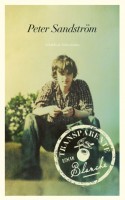 Transparente blanche
Transparente blanche
Helsinki: Schildts & Söderströms, 2014. 226 pp.
ISBN 978-951-523-461-2
€ 28, hardback
Finnish translation:
Valkea kuulas
Suomentanut [Translated by] Outi Menna
Helsinki: Schildts & Söderströms, 2014
ISBN 978-951-523-415-5
Peter Sandström debuted in 1998. His sixth book, the novel Transparente blanche [White transparent: apple variety], is about a middle-aged man who returns to the place of his upbringing and his elderly mother to help her with a strange task she has been given. He is confronted with memories of crucial experiences of his youth – the early death of his father, and his first love – experiences which, the reader understands, guided his life and made him the alienated person he is. The novel also depicts in an unusually sensitive and penetrating way the relationship between a grown man and his mother. However, plot is never the focus of Sandström’s books. His interest lies in using a specific environment and precise and poetic language to depict the vaguest of existential experiences: transience, mortality, changes in the perception of one’s body and in things, the unreliability of memories, the enigma of other people, all that it means to be human, impermanent and thrown into the stream of time.

